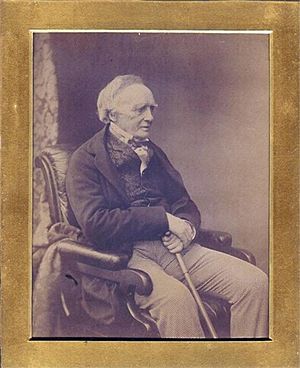Lord William Douglas facts for kids
Lord William Robert Keith Douglas (born 1783 – died 5 December 1859) was an important British politician and a person who owned land. He was the fourth son of Sir William Douglas. His older brothers were Charles Douglas, 6th Marquess of Queensberry and John Douglas, 7th Marquess of Queensberry.
Lord William served in the British Parliament. He represented the area called Dumfries Burghs from 1812 to 1832. He also worked several times as a Lord Commissioner of the Admiralty. This role involved helping to manage the British Navy.
He owned large sugar farms in Tobago, an island in the Caribbean. These farms had belonged to Walter Irvine before. Lord William married Walter Irvine's daughter, Elizabeth, on 24 November 1824. They had three sons. Their second son, Walter, continued the family line known as the Douglases of Grangemuir. A woman named Catherine Grant, who later became a missionary, worked for him as a teacher for his children until 1843.
Contents
About His Life and Work
Lord William Robert Keith Douglas was a key figure in British politics during his time. He helped make decisions for the country as a Member of Parliament. His work as a Lord Commissioner of the Admiralty showed his involvement in important government roles.
His Family and Titles
In May 1837, Lord William's oldest brother became the Marquess of Queensberry. After this, Lord William was given a special honor. This honor meant he could use the title "Lord" before his name. It showed he had the same rank as a younger son of a Marquess.
His Burial Place
Lord William is buried in a village called Dunino in Fife, Scotland. This village is close to his family's main home, Grangemuir, which is near Pittenweem.
Historical Context of His Wealth
According to the Legacies of British Slave-Ownership at the University College London, Lord William Douglas received money after slavery was ended. This happened because of the Slavery Abolition Act 1833 and the Slave Compensation Act 1837.
The British Government borrowed a large sum of money, about £15 million, to pay people who owned enslaved individuals. This money was borrowed from bankers like Nathan Mayer Rothschild and Moses Montefiore. British taxpayers paid back this loan over many years, finally finishing in 2015.
Lord William Douglas was connected to three claims for compensation. He received a payment of £10,907. This payment was for 576 enslaved people on his sugar farms in Tobago.
See also


